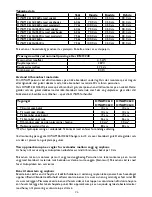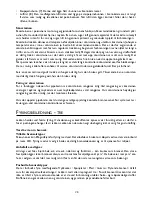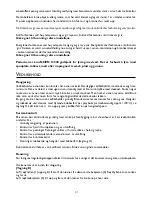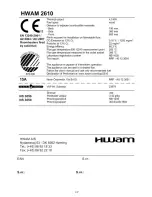
37
F
IrIng
manual
-
wood
The lacquer will be fully hardened after the stove has been used, and the door and the ashpan should be
opened very carefully as there will otherwise be a risk that the gaskets will stick to the lacquer. In addi-
tion the lacquer may initially give off an unpleasant odour, so make sure that the room is well ventilated.
Tips about fuel
Approved fuel types
The wood burning stove is EN approved for combustion of wood only. It is recommended to use dried
chopped wood with a water content of a maximum of 20%. Stoking a fire with wet wood results in soot,
environmental problems, and a less efficient fuel economy.
Recommended wood types
All types of wood, for instance birch, beech, oak, elm, ash, conifers, and fruit trees can be used as fuel
in your wood burning stove. The great difference is not in the fuel value, but in the weight of the wood
types per cubic metre. Since beech weighs more per cubic metre than for instance common spruce, it
will take more common spruce to produce the same amount of heat that you would get from a cubic
metre of beech.
Banned fuel types
It is not allowed to stoke a fire with the following: printed matter, plywood, plastic, rubber, fluid fuels,
and rubbish such as milk cartons, lacquered wood or impregnated wood and fossil fuels. The reason that
you should not apply any of the above is that during combustion they develop substances that are health
hazardous and harmful to the environment. These substances could also damage your wood burning stove
and chimney, rendering the product warranty void.
Storage of wood
A water content of a maximum of 20% is achieved by storing the wood for a minimum of one year,
preferably two years, outdoors under a lean-to. Wood stored indoors has a tendency to become too
dry and combust too quickly. However, it might be advantageous to store fuel for lighting a fire indoors
for a few days prior to use.
Recommended dimensions
The dimensions of the fuel are important to good combustion. The dimensions should be as follows:
Fuel type
Length in cm
Diameter in cm
Wood for kindling a fire (finely chopped)
16-25
2-5
Chopped wood
16-25
7-9
Lighting the stove (drawing D)
A successful combustion process requires that the wood is lit in the right way. A cold stove and a cold
chimney challenge the combustion process. It is important to achieve a high flue gas temperature quickly.
Turn the regulator (1) clockwise to maximum. Place two pieces of wood (5-8 cm in diameter) horizontally
in the bottom of the combustion compartment (corresponding to 1-2 kg). Place the firewood on top
of the air gaps at the front of the combustion chamber bottom, as this will allow for easy lightning. Do
not place the firewood too close to the door glass. Place 5-8 pieces of kindling randomly on top. Never
pile wood above the air slot in the vermiculite rear plate. Place two firelighters between the top layer
of kindling. Light up the fire-lighters and close the stove door. If condensation forms on the glass, keep
the door ajar for a little while and close again. When the kindling is burning well, turn the regulator (1)
to middle position.
Содержание 2610
Страница 2: ...2 ...
Страница 4: ...4 B C A 3 1 1 4 45 4 3 2 1 11 12 14 14 15 9 11 10 17 14 12 13 1 4 6 5 15 7 8 16 ...
Страница 5: ...5 E F D 1 1 2 3 ...
Страница 6: ...6 G ...
Страница 7: ...7 H ...
Страница 42: ...42 ...
Страница 43: ...43 ...
Страница 44: ...44 ...
Страница 45: ...45 ...
Страница 46: ......
Страница 47: ......












































